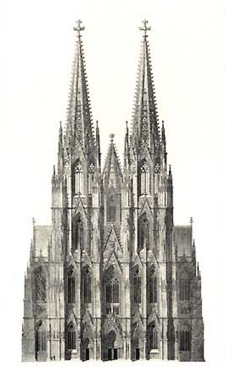
Dome in Cologne - one of the tallest cathedrals in the world
 |
The foundation stone of the dominant feature of one of the oldest German cities was laid on August 15, 1248, at the site of an old Romanesque church. The construction of the temple, inspired by French cathedrals, progressed quickly at first, allowing its choir to be consecrated in 1322. A few years later, the construction was apparently participated in by Peter Parler, who later applied his experience in building St. Vitus Cathedral in Prague.
A lack of funds halted the building of the Cologne Cathedral around the mid-16th century, and only at the beginning of the 19th century did a neo-romantic enthusiasm for all things medieval help gather enough financing, partly from collections of Cologne citizens. The last to be completed were the two towers in 1880, which are part of the complex of the five-nave cathedral with a transverse triple nave and a wreath of chapels, covering a total area of nearly eight thousand square meters.
A unique work of art in the cathedral, which measures 144 meters in length and 86 meters in width, is the sarcophagus, which is believed to contain the remains of the biblical Three Kings. The relics of Caspar, Melchior, and Balthazar were brought from Milan in 1164 by Archbishop Rainald of Dassel, thereby catapulting Cologne to the top tier of pilgrimage sites of the time.
Other treasures of the cathedral, which is dedicated to St. Peter and the Virgin Mary, include the statues on the choir columns (approximately from 1320) or Gero's cross, commissioned by Archbishop Gero in the 10th century, featuring a life-sized crucified Christ.
During World War II, the cathedral was hit several times during bombings, but fortunately was not completely destroyed. Its post-war reconstruction was completed in 1956, and 40 years later, this Gothic gem was inscribed on the UNESCO World Heritage List. However, since last year, it has also been on the list of endangered monuments, partly due to several high-rise buildings constructed nearby.
A few years after its completion, the Cologne Cathedral held the title of the tallest building in the world; today, with its height of 157.4 meters, it ranks fifth among cathedrals worldwide and fourth in Europe. The tallest Gothic cathedral in the world, with a tower measuring 161.5 meters, now stands in Ulm, Germany. Theoretically, it could be surpassed in the future by the Sagrada Familia Cathedral, whose main tower is planned to measure 170 meters. However, this Barcelona temple is only one-fifth complete and will likely not be finished until St. Joseph does so, as its author Antonio Gaudí once said.
The English translation is powered by AI tool. Switch to Czech to view the original text source.
0 comments
add comment










